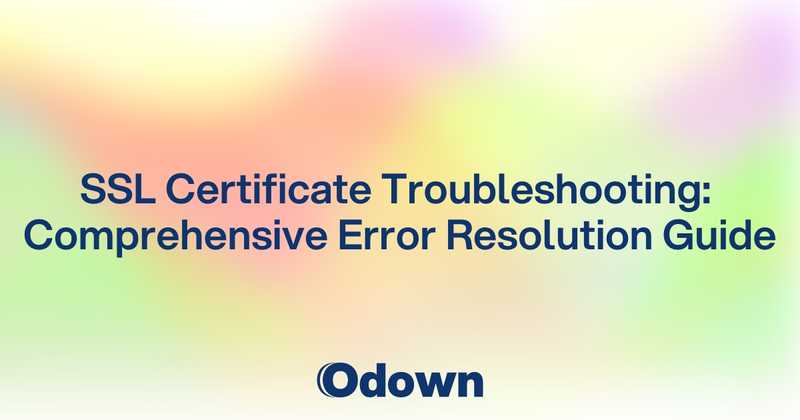SSL Certificate Troubleshooting: Comprehensive Error Resolution Guide
SSL certificates form the backbone of secure web communications, but they can also be a common source of frustration for administrators and developers. When certificate issues arise, they can lead to alarming browser warnings, reduced user trust, and even complete service inaccessibility. Understanding how to quickly diagnose and resolve SSL certificate problems is an essential skill for anyone responsible for website reliability.
This comprehensive guide walks through the most common SSL certificate errors, their underlying causes, and step-by-step troubleshooting procedures to resolve them. By following these methodical approaches, you can minimize downtime and maintain secure connections for your users.
Common SSL Certificate Errors and Their Causes
Browser Error Messages and Their Meanings
Chrome Error Messages
- "Your connection is not private" (NET:: ERR_CERT_AUTHORITY_INVALID)
- "Your connection is not private" (NET:: ERR_CERT_DATE_INVALID)
- "Your connection is not private" (NET:: ERR_CERT_COMMON_ NAME_INVALID)
- "Your connection is not private" (NET:: ERR_CERT_WEAK_ SIGNATURE_ALGORITHM)
Firefox Error Messages
- "Warning: Potential Security Risk Ahead" (MOZILLA_PKIX_ ERROR_SELF_SIGNED_CERT)
- "Warning: Potential Security Risk Ahead" (MOZILLA_PKIX_ ERROR_NOT_YET_ VALID_CERTIFICATE)
- "Warning: Potential Security Risk Ahead" (MOZILLA_PKIX_ ERROR_EXPIRED_CERTIFICATE)
- "Warning: Potential Security Risk Ahead" (SSL_ERROR_ BAD_CERT_DOMAIN)
Safari Error Messages
- "This Connection Is Not Private" (Certificate is not trusted)
- "This Connection Is Not Private" (Certificate is invalid)
- "This Connection Is Not Private" (Certificate has expired or is not yet valid)
Server-Side Error Messages
- "SSL handshake failed"
- "SSL library error: error:14094410:SSL routines:ssl3_read_bytes:sslv3 alert handshake failure"
- "SSL23_GET_SERVER_HELLO: unknown protocol"
- "No shared cipher"
- "Certificate verify failed"
Root Causes of Certificate Errors
Certificate Validity Issues
- Expired certificates
- Certificates not yet valid (incorrect system time)
- Revoked certificates
- Self-signed certificates used in production
Certificate Trust Issues
- Missing intermediate certificates
- Untrusted Certificate Authority (CA)
- Certificate chain ordering problems
- Root certificate not in browser's trust store
Certificate Content Issues
- Common Name (CN) or Subject Alternative Name (SAN) mismatch
- Wildcard certificate limitations
- Extended Validation (EV) certificate requirements not met
- Incorrect certificate usage type
Server Configuration Issues
- Protocol mismatches (e.g., TLS 1.0 vs TLS 1.3)
- Cipher suite incompatibilities
- Server Name Indication (SNI) configuration problems
- Virtual host misconfiguration
Client-Side Issues
- Outdated browser or operating system
- Incorrect system time
- MITM (Man-in-the-Middle) proxy interference
- Antivirus software interception
Certificate Chain Validation Problems
What is a Certificate Chain?
A certificate chain is a sequence of certificates that links your server's certificate back to a trusted root certificate authority. The chain typically consists of:
- Your server's end-entity certificate
- One or more intermediate certificates
- A root certificate (pre-installed in browsers and operating systems)
Common Chain Validation Issues
- Missing Intermediate Certificates
- Incorrect Chain Order
- Cross-Signed Certificates
- Path Length Constraints
- Expired Intermediate Certificates
Identifying Chain Problems
Typical error messages:
- "Unable to verify the first certificate"
- "Unable to get local issuer certificate"
- "Certificate not trusted"
- "Invalid certificate chain"
Chain Verification Tools
openssl verify -CAfile chain.pem server.crt
- Qualys SSL Labs Server Test (online)
testssl.sh
sslyze
Name Mismatch and Expired Certificate Fixes
Certificate Name Mismatch
- Using an IP address instead of a domain name
- Accessing the site through a different domain or subdomain
- Using a wildcard certificate incorrectly
- Load balancer or CDN configuration issues
Expired Certificates
- Missed renewal notifications
- Automated renewal failures
- Certificate management across multiple systems
- Responsibility gaps between teams
Step-by-Step Troubleshooting Procedures
Diagnosing Certificate Issues with OpenSSL
- Check Certificate Validity:
-in certificate.crt \
-text \
-noout
- Verify Server Certificate Presentation:
-connect example.com:443 \
-servername example.com
- Check Certificate Chain Validity:
-CAfile chain.pem \
certificate.crt
- Test Specific TLS Version:
-connect example.com:443 \
-tls1_2
Browser-Based Troubleshooting Techniques
Chrome:
- Press F12 → Security Tab → View Certificate
Firefox:
- Click padlock → More Information → View Certificate
Common SSL Certificate Error Resolutions
Expired Certificate
- Check with
openssl x509 -in certificate.crt -noout -enddate
- Renew and deploy new certificate
- Restart services
- Implement monitoring
Missing Intermediate Certificate
- Identify via browser or OpenSSL
- Download intermediate cert
- Concatenate:
- Restart server and verify
Name Mismatch
- Verify mismatch:
-connect example.com:443
| grep -A1 "subject="
- Request corrected certificate or update DNS
Self-Signed Certificate
- Use CA-issued cert for production
- For internal use, add to trust store
Incorrect Certificate Chain Order
- Reorder and concatenate correctly
- Deploy updated chain
Weak Cipher or Protocol
- Test with:
--script ssl-enum-ciphers \
-p 443 \
example.com
- Disable weak protocols/ciphers
- Retest after changes
Advanced Troubleshooting for Complex Issues
Certificate Revocation
- CRL check:
-in crl.pem \
-text \
-noout
- OCSP check:
-issuer issuer.crt \
-cert certificate.crt \
-url http://ocsp.example.com
Debugging TLS Handshake
- Trace:
-connect example.com:443 \
-debug
Client-Specific Issues
- Try different browsers/devices
- Verify system time
- Clear SSL state
- Update software
Preventing SSL Issues Through Proactive Monitoring
Certificate Expiration
- Multi-channel alerts (email, SMS)
- Ownership tracking
- Centralized inventory
Certificate Validation
- Daily or weekly scans
- Mobile and desktop validation
- Geo-distributed monitoring
CI/CD Validation
- Block faulty certs before deployment
- Include staging/dev tests
SSL Configuration Hardening
Best Practices
- Disable SSL 2.0, SSL 3.0, TLS 1.0/1.1
- Use strong ciphers, ECC keys, or 2048+ RSA
- Enable HSTS and OCSP stapling
Vulnerability Checks
- Regular scans for BEAST, POODLE, Heartbleed
- Stay current on patches
Implementing Automated Certificate Management
ACME-Based Automation
- Use Certbot or cert-manager
- Automate validation and renewal
Centralized Management
- Role-based access
- Audit trails
- Zero-downtime deployment
Troubleshooting Case Studies
Case 1: E-commerce Chain Issue
- Cause: Missing intermediate
- Fix: Updated chain, automated deployment
Case 2: Load Balancer Mismatch
- Cause: Inconsistent certs across nodes
- Fix: Synced certs and validated per node
Case 3: CDN Certificate Propagation Delay
- Cause: Edge caching expired cert
- Fix: Forced update, adjusted timing
Building an SSL Certificate Incident Response Plan
Key Components
- Certificate inventory
- Contact list for CAs
- Emergency renewal paths
- Comms templates
Templates
- Technical: issue, current state, fix
- Management: impact, resources, risk
- Customer: plain-language status + workaround
Conclusion
SSL troubleshooting is essential for security and uptime. A proactive approach with automated monitoring, structured troubleshooting, and strong configuration practices will prevent most issues before they start.



